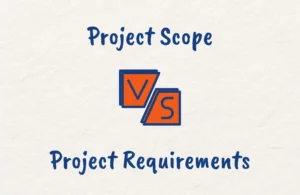When managing a project, it is important to have a well-defined scope. Establishing a strong project scope baseline is key to setting clear expectations and maintaining control.
The scope baseline captures your project’s agreed deliverables, goals, timelines, costs, and risks. It provides a documented understanding of the intended scope that all stakeholders align on.
Having a well-defined scope baseline lays the foundation for the team to deliver within the agreed scope which enables you to measure progress, guide execution, and prevent scope creep which is very common in projects.
In this post, we will explore project scope baselines in-depth, from their components to how to create one effectively to set your project up for success.
What is a Project Scope Baseline?
A project scope baseline is the approved and documented definition of a project’s scope. It sets the boundaries and goals for what will be delivered by the project team.
The scope baseline formally defines all aspects of the project scope and is used to measure performance. It serves as a reference point to determine whether requests lead to scope creep.
The key components of a scope baseline include:
- Scope Statement: Documents the goals, deliverables, assumptions, and constraints.
- Work Breakdown Structure (WBS): Breaks down the project deliverables into smaller components.
- WBS Dictionary: Provides additional details on each WBS element such as description, budget, timeline, and responsibilities.
Once approved by stakeholders, these documents together form the project scope baseline and provide you with the foundation to execute the project within the agreed scope.

Components of a Scope Baseline
As earlier iterated, a project scope baseline consists of three key components which together provide a detailed definition of the project scope baseline. These are:
1. Scope Statement
The scope statement provides a high-level overview of the project scope and documents the goals, deliverables, assumptions, constraints, and acceptance criteria of the project.
It should clearly define what is included and excluded from the project to help avoid scope creep from uncontrolled changes down the road.
2. Work Breakdown Structure (WBS)
The WBS breaks down the deliverables into smaller, more manageable components called work packages. It displays the hierarchy and helps organize the work into phases.
It is an essential tool to visualize the scope and support activity planning. The lowest level of the WBS consists of work packages that can be easily assigned and executed.
3. WBS Dictionary
The WBS dictionary provides detailed information for each element of the WBS. This can include:
- Description of the work
- Responsible team or person
- Timeline and milestones
- Budget and resources
- Quality metrics
- Risks and assumptions
Having this information documented is crucial for successfully managing each work package.

How to Create a Project Scope Baseline
To create a well-defined project scope baseline, follow these key steps:
1. Develop the Scope Statement
- Document the goals, main deliverables, assumptions, constraints, and acceptance criteria.
- Get input from stakeholders to ensure shared understanding.
- Clearly define what is included and excluded from the scope.
2. Create the WBS
- Break down the deliverables into manageable work packages.
- Show the hierarchy and structure of the work.
- Decompose the work into sufficient detail for planning and tracking.
- Ensure the lowest level work packages can be practically executed.
3. Build the WBS Dictionary
- Provide details for each WBS component like description, budget, timelines, risks, quality expectations, and responsible team/person.
- Document relevant information needed to manage the work package.
4. Seek Formal Approval
- Seek sign-off on the scope baseline documents from all stakeholders.
- Get approval from oversight committees or governance processes if required.
- Confirm stakeholder agreement on the defined scope.
5. Communicate the Scope Baseline
- Share the approved scope baseline with the entire project team.
- Ensure a common understanding of the scope boundaries.
- Use it as a reference to keep work aligned with the defined scope.
Purpose of the Project Scope Baseline
Defining a clear project scope baseline is critical for setting expectations and maintaining control of the project. A robust scope baseline serves several key purposes:
1. Sets Scope Expectations
Having a well-documented scope baseline helps manage expectations by outlining project boundaries. It provides:
- A clear description of the intended project scope that is agreed upon by all stakeholders.
- A definition of key goals and deliverables to be produced by the project team.
- Boundaries that clarify what is included and excluded from the project scope.
- Documentation to reference when questions arise on scope coverage.
This enables you to keep stakeholders aligned on project scope delivery.
2. Measures Performance
The scope baseline establishes the plan you will measure project performance against. It allows you to:
- Compare actual progress and deliverables to the baselined scope, schedule, and budget.
- Identify performance issues, trends, and project health by analyzing variances.
- Take corrective action when significant deviations occur from the baselined plans.
3. Controls Scope Creep
An approved scope baseline limits uncontrolled scope changes which often derails timelines and budgets. It mandates:
- Following formal change control processes for any proposed scope changes.
- Assessing the impact of scope changes on cost, schedule, resources, and risks.
- Getting approval from oversight committees per governance processes.
4. Facilitates Planning
Having a detailed scope baseline provides the foundation for comprehensive project planning including:
- Sequencing project activities.
- Estimating resources needed based on defined scope components.
- Developing realistic timelines integrated across project workstreams.
- Budgeting work efforts based on well-defined scope expectations.

Scope Baseline vs Scope Statement
The scope baseline and scope statement are key components of project management, particularly within the framework of the Project Management Body of Knowledge (PMBOK) guide.
Here’s how they differ:
Scope Statement
The scope statement is a part of the project management plan developed at the beginning of a project which defines, in detail, the project’s deliverables, and the work required to complete those deliverables.
It’s a foundational element that provides a detailed description of the project and product and ensures that all of the project work and only the project work is included
Key aspects of the scope statement include:
- Project Objectives: The desired outcomes of the project, often defined in terms of cost, schedule, and quality.
- Deliverables: Specific items or services that must be produced to consider the project or a phase of the project complete.
- Exclusions: Clearly states what is out of the project’s scope, preventing scope creep.
- Constraints: Factors that limit the project team’s options, like budget, timeline, or resources.
- Assumptions: Things assumed to be true for the project planning to proceed.
Scope Baseline
The scope baseline, on the other hand, is a component of the project management plan that includes the approved version of a scope statement, the Work Breakdown Structure (WBS), and its associated WBS dictionary.
It serves as a baseline to measure project performance and control project scope.
Differences Between the Scope Baseline and Scope Statement
Level of Detail
The scope statement is a high-level document that outlines the project and product scope, while the scope baseline includes the scope statement but adds detailed information about the “how” of the project through the WBS and WBS dictionary.
Change Control
The scope statement is subject to change as the project plan evolves, but once it’s part of the scope baseline, any changes to it require formal change control procedures.
Usage
The scope statement ensures that stakeholders have a common understanding of what is included in the project. In contrast, the scope baseline is used to measure project performance and manage scope changes throughout the project.
Project Scope Baseline Example
Let’s look at a project scope baseline example for building a new customer mobile app.
Scope Statement
The scope statement summarizes that the project will deliver a cross-platform mobile app for customers to manage their accounts. Key deliverables are:
- Mobile app for iOS and Android
- Key features – account overview, payments, notifications, profile management
- Enhanced security protocols
- Seamless integration with back-end account systems
The project is constrained by a 9-month timeline and a $500k budget.
Work Breakdown Structure (WBS)
The work breakdown structure organizes the project into phases with the following high-level components:
- Planning
- Design
- Core app development
- Testing
- Implementation
Each phase is further broken down into major deliverables and subtasks.
WBS Dictionary
The WBS dictionary provides additional details on each WBS component such as:
- Planning – identify features, timeline, costs
- Design – UI/UX design, architecture diagrams
- Development – sprint delivery of app features, security controls
- Testing – unit testing, user acceptance testing
- Implementation – release planning, app store publishing

Project Scope Baseline PMP Exam Tips
If you are preparing for the PMP certification exam, the project scope baseline is an integral aspect of project scope management that you need to have a firm grasp of.
As outlined in the PMBOK® Guide, the Project Scope Baseline is a critical component of project management, which encompasses the project scope statement, the Work Breakdown Structure (WBS), and the WBS dictionary.
It is established during the project planning phase and serves as a reference point for managing project scope.
Creation Process
- Collect Requirements: Gathering what stakeholders need from the project.
- Define Scope: Detailing the project and product.
- Create WBS: Breaking down the scope into manageable tasks.
Utilization
- Validate Scope: Formalizing acceptance of the completed project deliverables.
- Control Scope: Monitoring the status of the project and managing changes to the scope baseline.
For the PMP exam, understand that the Project Scope Baseline is not static; it can be modified through a formal change control process.
Knowing the processes in which it is created and applied is vital for effective scope management and is a key area of knowledge for PMP candidates.
Conclusion
A clearly defined project scope baseline is essential to setting expectations, guiding execution, and controlling scope creep.
Be sure to invest time upfront in developing a robust scope statement, work breakdown structure, and WBS dictionary. Get formal approval from all stakeholders to baseline the scope.
Then use these documents to align your team and measure performance. Now you have a better understanding of project scope baselines and how to leverage them for managing projects successfully.
Project Scope Baseline FAQs
Is Scope Baseline Part of Project Charter?
No, the scope baseline is not part of the project charter. The scope baseline is developed during the project planning phase, while the project charter is a document issued at the project’s start to formally authorize its existence.
What is a Scope Baseline Review?
A Scope Baseline Review is a formal evaluation process where the project’s defined scope baseline, which includes the scope statement, WBS, and WBS dictionary, is assessed for accuracy and completeness to ensure project alignment with objectives.
Who Approves the Project Scope Baseline?
The project scope baseline is typically approved by the project sponsor or stakeholders, often after a review by the project manager and the project team to ensure it aligns with the project’s objectives and deliverables.





